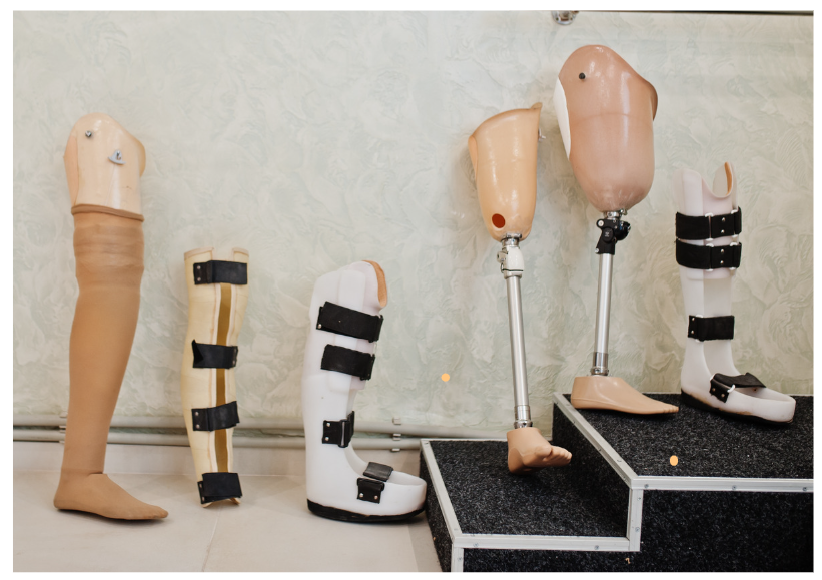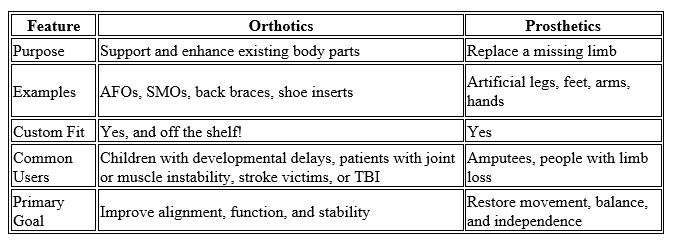Orthotics vs. Prosthetics: What’s the Difference?

At Alliance Prosthetics and Orthotics, a common question we hear is: “What’s the difference between orthotics and prosthetics?”
While both help improve mobility, comfort, and quality of life, they serve very different purposes. Whether you're recovering from an injury, managing a chronic condition, or adapting to limb loss, understanding these terms can help you feel more informed and empowered on your care journey.
________________________________________
What Are Orthotics?
Orthotics are custom-designed medical devices that support, align, or enhance the function of existing body parts—most often the limbs or spine. These devices are worn externally and can play a crucial role in improving balance, alleviating pain, and preventing further injury.
Common Types of Orthotic Devices:
- Foot orthotics (shoe inserts): Help with arch support, heel pain, and gait correction.
- Ankle-Foot Orthoses (AFOs): Stabilize the ankle and foot, commonly used for stroke recovery, drop foot, and cerebral palsy.
- Supramalleolar Orthoses (SMOs): These are shorter than AFOs and wrap around just above the ankle bones (malleoli). They’re often used in children with low muscle tone or mild instability to help correct pronation and support better balance while walking.
- Knee braces: Provide support for injuries, instability, or joint degeneration.
- Spinal orthoses (back braces): Help align or support the spine in cases of scoliosis, fractures, or post-surgery recovery.
Who Benefits from Orthotics?
Orthotics may be recommended for:
- Children with developmental or neuromuscular conditions (like hypotonia or cerebral palsy)
- Adults recovering from orthopedic injuries
- Adults recovering from stroke or TBI
- Patients with chronic pain in the feet, knees, or back
- People with muscular weakness or joint instability
- Anyone needing improved support for standing, walking, or balance
________________________________________
What Are Prosthetics?
Prosthetics are custom-made artificial limbs used to replace a missing body part — most commonly an arm, leg, hand, or foot. These devices are built with precision to match an individual's body, lifestyle, and personal goals, helping restore both function and confidence.
Types of Prosthetic Limbs:
- Upper-limb prosthetics: Replace the arm, hand, or fingers. Can range from basic cosmetic limbs to highly functional myoelectric devices.
- Lower-limb prosthetics: Replace the leg, foot, or knee. These are essential for restoring mobility after an amputation due to trauma, illness, or congenital conditions.
Who Uses a Prosthesis?
A prosthesis may be needed after:
- Trauma (e.g., accidents or combat injuries)
- Medical amputation (due to diabetes, cancer, or vascular disease)
- Congenital limb difference (born with part of a limb missing or underdeveloped)
________________________________________
Key Differences at a Glance
What Makes Alliance Prosthetics and Orthotics Different?
At Alliance Prosthetics and Orthotics, we believe in more than just delivering high-quality devices — we believe in building strong relationships, providing education, and crafting individualized solutions that grow with you.
Whether you're a parent exploring orthotics like SMOs for your child or a patient preparing for life after an amputation, we’re here with clinical expertise and compassionate care to support every step of your journey.
________________________________________

